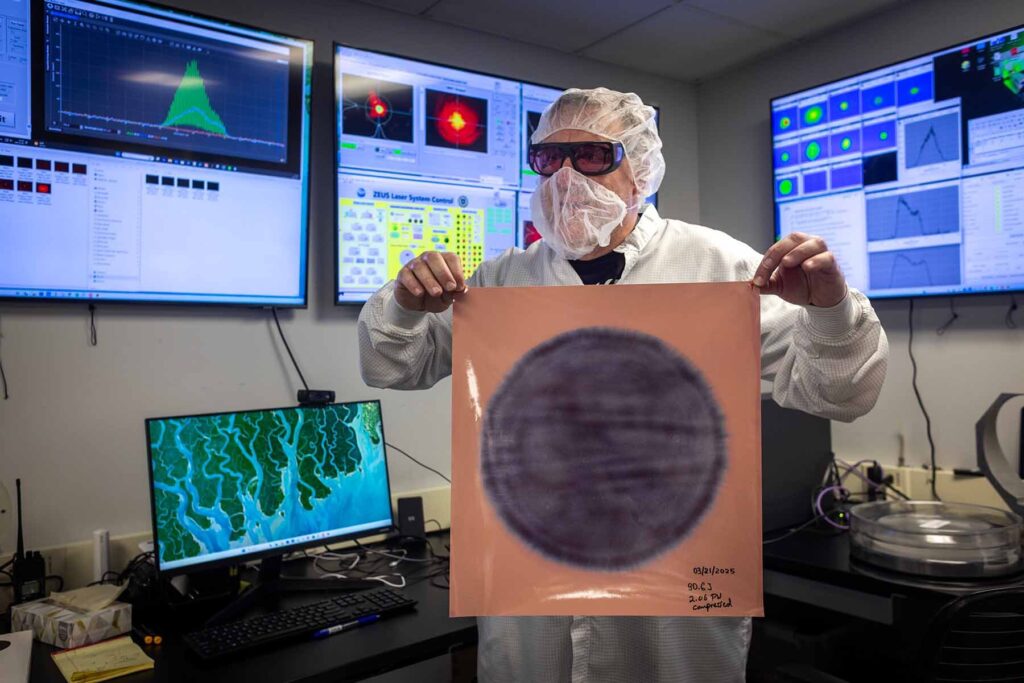
A facility the size of a school gymnasium, discreetly located at the University of Michigan, is at the forefront of laser technology. Known as ZEUS—short for Zettawatt Equivalent Ultrashort laser pulse System—it has recently set a new benchmark by achieving a peak power of 2 petawatts. This power surge, equivalent to 2 quadrillion watts, surpasses the total energy consumption of the entire planet by over 100 times. Despite lasting only 25 quintillionths of a second, this monumental pulse heralds a new era of scientific exploration.
“This milestone marks the beginning of experiments that move into unexplored territory for American high field science,” said Karl Krushelnick, director of the Gérard Mourou Center for Ultrafast Optical Science. With applications spanning quantum physics, plasma science, and astrophysics, ZEUS is already redefining the possibilities in high-intensity laser research.
Bursts of Light and the Edge of Physics
Building on the legacy of its predecessor, HERCULES, which peaked at 300 terawatts, ZEUS multiplies that power nearly sevenfold. As a pulsed laser, it emits ultra-short bursts of light so intense that they necessitate protective concrete shielding almost two feet thick. In this highly controlled environment, the laser’s energy is potent enough to strip electrons from atoms, creating a plasma—a turbulent mix of ions and electrons.
Researchers harness this energy by firing the laser into helium gas, generating waves in the plasma that electrons can “surf,” a process known as wakefield acceleration. Using a longer, less dense gas cell allows electrons more room and time to accelerate, reaching energy levels once thought impossible without massive particle accelerators.
At its full capacity, ZEUS will orchestrate a head-on collision between a stream of accelerated electrons and another laser pulse. Although this second pulse will measure only 3 petawatts, from the perspective of the speeding electrons, it will appear a million times more intense—a virtual zettawatt burst, inspiring the full name of ZEUS.
Designed for Discovery and Collaboration
Supported by $16 million in funding from the National Science Foundation, ZEUS is not merely a Michigan project; it is a national research facility open to scientists worldwide. Proposals from across the globe are selected through a rigorous peer-review process.
Franklin Dollar from the University of California, Irvine, leads the first official user experiment. His team aims to create electron beams with energies five to ten times higher than previously achieved at ZEUS, rivaling beams produced by traditional accelerators that stretch hundreds of meters long.
“One of the great things about ZEUS is it’s not just one big laser hammer,” Dollar remarked. “You can split the light into multiple beams.” This flexibility renders ZEUS unique, offering multiple experimental configurations within a single facility.
Vyacheslav Lukin, program director in the NSF’s Division of Physics, highlighted the broad impact of ZEUS. “The fundamental research done at the NSF ZEUS facility has many possible applications, including better imaging methods for soft tissues and advancing the technology used to treat cancer and other diseases.”
Behind the Beam: How ZEUS Works
To generate its colossal bursts of light, ZEUS begins with an infrared pulse. Optical gratings stretch it out in time, preventing the pulse from becoming too intense too quickly. Through four stages of amplification, the laser builds up to its full power. At one stage, the beam stretches 12 inches wide and several feet long, but before striking its target, it is compressed to less than a micron in width.
This focus elevates intensity to staggering levels—sufficient to trigger exotic physics, such as particle creation and quantum field effects typically observed near black holes or in particle accelerators. It is this power that makes ZEUS an invaluable scientific instrument.
Despite its size and complexity, ZEUS operates with agility. “As a midscale-sized facility, we can operate more nimbly than large-scale facilities like particle accelerators or the National Ignition Facility,” said John Nees, who leads laser construction at ZEUS. “This openness attracts new ideas from a broader community of scientists.”
The Road to Full Power
Achieving 2 petawatts was no simple task. The system required years of meticulous planning and the acquisition of rare materials. One significant challenge was obtaining a specialized titanium-doped sapphire crystal nearly 7 inches in diameter, serving as the final amplifier for the beam, which took four and a half years to produce.
Even after reaching 1 petawatt, the team encountered concerning signs. The optical gratings darkened, raising fears of permanent damage. Fortunately, testing revealed it was merely carbon deposits from stray molecules being disintegrated by the laser. After confirming this, researchers determined how many shots could be safely fired before cleaning became necessary.
To date, ZEUS has hosted 11 different experiments involving 58 scientists from 22 institutions. While the current laser is powerful, many researchers are already preparing for the next phase: reaching 3 petawatts. Once the new sapphire crystal is installed, the laser’s true potential will be unleashed.
Looking ahead, the ZEUS team will continue to support external researchers while making upgrades between experiments. By providing broad access to such advanced technology, ZEUS is positioning the United States to reclaim leadership in ultrafast laser science.
As Krushelnick, who also holds multiple professorships in engineering and physics, noted, this new frontier is about more than just power. It’s about discovery. It’s about enabling experiments that can unlock a deeper understanding of matter, energy, and the forces that shape the universe.
Most Powerful Lasers on Earth
Here are the five most powerful lasers on Earth as of mid-2025, ranked by their peak power output in petawatts (PW). These lasers are designed for cutting-edge physics experiments, including fusion research, high-energy density science, and probing the fundamental nature of matter.
- ELI-NP Laser (Romania)
Power: 10 petawatts (PW) per beam, 20 PW total
Location: Măgurele, Romania
Facility: Extreme Light Infrastructure – Nuclear Physics (ELI-NP)
Purpose: Research in nuclear photonics, quantum electrodynamics, and high-intensity laser-matter interactions. - SULF Laser (China)
Power: 10 PW
Location: Shanghai, China
Facility: Shanghai Superintense Ultrafast Laser Facility (SULF)
Purpose: High-field physics and quantum electrodynamics using ultra-short femtosecond pulses. - Apollon Laser (France)
Power: 5 PW (planned upgrade to 10 PW)
Location: Paris-Saclay, France
Facility: Laboratoire d’Utilisation des Lasers Intenses (LULI)
Purpose: Studies of relativistic laser-plasma interactions and high-energy particle acceleration. - ZEUS Laser (USA)
Power: 3 PW (expandable to 20 PW in future stages)
Location: University of Michigan, Ann Arbor, USA
Facility: ZEUS (Zettawatt-Equivalent Ultrashort pulse laser System)
Purpose: Simulates extreme astrophysical environments and supports advanced particle physics experiments. - Vulcan Laser (UK)
Power: 1 PW (upgrade to 20 PW planned)
Location: Rutherford Appleton Laboratory, Oxfordshire, UK
Facility: Central Laser Facility
Purpose: High-energy-density physics, inertial confinement fusion, and laser-driven particle acceleration.
These lasers represent the pinnacle of photonics and are essential tools for next-generation physics, nuclear fusion, and probing the quantum vacuum.







